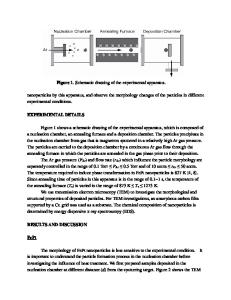Template-Free Synthesis of Ellipsoidal Silica Nanoparticles
- PDF / 7,457,177 Bytes
- 5 Pages / 612 x 792 pts (letter) Page_size
- 23 Downloads / 344 Views
Template-Free Synthesis of Ellipsoidal Silica Nanoparticles Henan Zhang, Daniel L. Akins Department of Chemistry, The City College of The City University of New York New York, NY, 10031, U.S.A. ABSTRACT For a sol-gel process occurring in a water/oil (w/o) system, the self-assembly of silica nuclei can be controlled by close control of synthesis conditions. We have synthesized ellipsoidal or spherical silica particles by a template-free scheme that involves controlling surface tension on silica nuclei through via use of different volume ratios of a w/o micellar system. INTRODUCTION A wide range of silica materials have proven interesting from a basic science perspective as well as due to their crucial roles in everyday commercial applications, such as energy storage scaffolding, chem- and bio-sensors support agents, food processing materials, drug delivery components, and elements of catalysis systems.1-6 As has been found by many researchers, solvents play a crucial role, in a template free approach, in determining the overall morphologies and compositions of resultant silica materials. As examples, a water/ethanol reaction system has been used to control the diameters of spherical silica particles and to convert silica particles from solid spherical to hollow spherical.7 In addition to the water/ethanol system, morphologically controllable mesoporous silica nanoparticles have been synthesized using water/acetone solvents.8 Moreover, water/methanol, ethylene glycol, polyethylene glycol, glycerine, and poly(vinyl alcohol) (PVP) have been utilized to modify the size of porous spherical silica particles.9 It is to be noted that, despite the fact that extensive efforts have been made to modify the morphology of silica materials with different solvents, the vast majority of the published literature point to the formation of silica structures that are either spherical-hollow,-mesoporous, or -solid. As a result, it would appear clear that self-assembled, spherical shapes are generally favored and would likely occur for any homogeneous synthesis process. Additionally, the formation of silica materials with nonspherical morphologies is generally made possible through utilization of nonsymmetrical templates.10,11 As examples of this latter fact, we note that αFe2O3 spindles have been used as templates to fabricate silica ellipsoids. Specifically, Lou et al.12 have coated α-Fe2O3 spindles with silica to form structured materials that are classified as nonspherical rattles. Also, many inorganic materials with unique nanostructures have been fabricated by template-directed approaches. 13 However, the complexity of the preparation and the presence of nonremovable solid cores have resulted in limited utility for the resultant silica nonspherical structures. Herein, a facile, template-free synthesis approach that possesses several advantages, including ease of preparation and possibly elimination of the need for a scaffold structure altogether, is discussed. Moreover, the silica ellipsoidal particles with porous texture might be ut
Data Loading...











